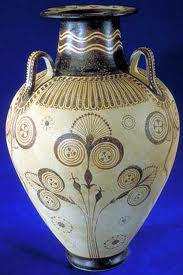It looks like you're using an Ad Blocker.
Please white-list or disable AboveTopSecret.com in your ad-blocking tool.
Thank you.
Some features of ATS will be disabled while you continue to use an ad-blocker.
share:
reply to post by beansidhe
Maybe. I was thinking along the lines that as with the Phoenicians and Carthaginians the idea of very powerful queens was more than just an idea. To them it was no problem if a king had only a female issue.
Carthimandua may be more of a title then. Harking back to the day recorded in these stones of a queen arriving in the area. I think Carthage was busted up 150bc? That would put the timeline closer.
Now apparently when she gave over Cradog to the Romans she had a revolt on her hands of some measure. Her loyalty with Rome wasn't reflected in the people she governed anyway. She later had to be taken away by the Romans. Again all this is speculation.
Maybe. I was thinking along the lines that as with the Phoenicians and Carthaginians the idea of very powerful queens was more than just an idea. To them it was no problem if a king had only a female issue.
Carthimandua may be more of a title then. Harking back to the day recorded in these stones of a queen arriving in the area. I think Carthage was busted up 150bc? That would put the timeline closer.
Now apparently when she gave over Cradog to the Romans she had a revolt on her hands of some measure. Her loyalty with Rome wasn't reflected in the people she governed anyway. She later had to be taken away by the Romans. Again all this is speculation.
reply to post by Logarock
It's really good speculation, particularly as lots of sources I've read say that the Picts carried on a matriarchal lineage. You would certainly record a queen arriving on stone, particularly one loyal to the hated Romans. Of course it could tell of her being taken away by the Romans, as well.
I need to go out for a bit, but I want to have another close look at that stone!
It's really good speculation, particularly as lots of sources I've read say that the Picts carried on a matriarchal lineage. You would certainly record a queen arriving on stone, particularly one loyal to the hated Romans. Of course it could tell of her being taken away by the Romans, as well.
I need to go out for a bit, but I want to have another close look at that stone!
reply to post by Logarock
Here's another one of these strange coincidences that keep appearing:
The Phoenician Alphabet
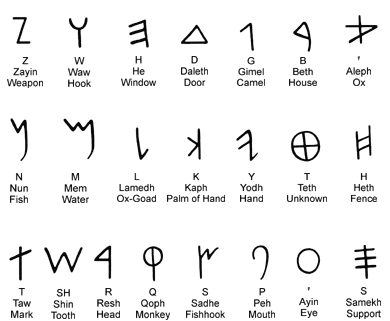
I mistakenly told Ramcheck that the Z was a Babylonian symbol for weapon; I was wrong, it's Phoenician. And look closely at their 'M', which is also the sign for water -
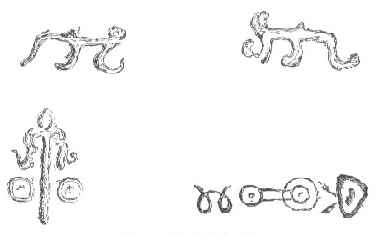
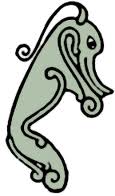
Could the beastie over the woman signify 'she came from over water/oversea'?
Here's another one of these strange coincidences that keep appearing:
The Phoenician Alphabet

I mistakenly told Ramcheck that the Z was a Babylonian symbol for weapon; I was wrong, it's Phoenician. And look closely at their 'M', which is also the sign for water -


Could the beastie over the woman signify 'she came from over water/oversea'?
Me again. According to your wiki link:
Or does she?
The Heroic Age
And just for good measure, to show you I've not gone completely mad:
Historic Scotland
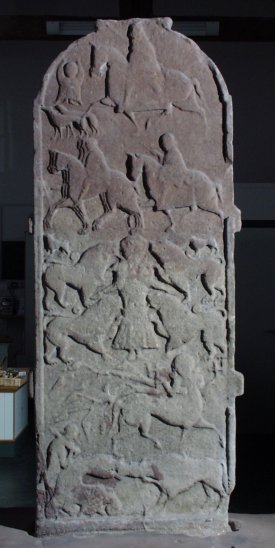
Oh my. Same hat.
I won't even start giving you links into the 'King Arthur was Scottish' story, or you'll be here all night. But it looks like Cartimandua might be right on the money, after all!
She was not so fortunate in 69. Taking advantage of Roman instability during the year of four emperors, Venutius staged another revolt, again with help from other nations. Cartimandua appealed for troops from the Romans, who were only able to send auxiliaries. Cartimandua was evacuated, leaving Venutius in control of a kingdom at war with Rome.[5] After this, Cartimandua disappears from the sources.
Or does she?
Cartimandua and Gwenhwyfar
The similarity between the activity of Cartimandua and the fate of Brigantia in the first century with Arthur's Queen Gwenhwyfar (Guinevere) and the fall of Arthur's realm in Geoffrey's History of the Kings of Britain is striking. The case of Cartimandua takes a mythical possibility for the activities of the personification of Brigantia into the realm of historical fact. Like Cartimandua, Gwenhwyfar is said to have replaced her husband Arthur with his trusted commander Medraut (Modred). According to Geoffrey of Monmouth, Medraut (Modred) recruited foreign troops from the Saxons; similarly, Cartimandua recruited help from the Romans.14 The result in both cases is a ferocious civil war that leads to the destruction of the kingdom and eventual domination by an outside force. Both parties also recruited foreigners; the Romans in the first century and the Angles in the fifth- to seventh-centuries in the north.
The Heroic Age
And just for good measure, to show you I've not gone completely mad:
Meigle 2 and the legend of Queen Guinevere
The majestic cross-slab known as Meigle 2 dominates the collection. It stands 2.5m high and probably stood beside the entrance to the churchyard. The stone features a wheel-headed cross with raised bosses, resembling the rivet heads of metalwork, and interlaced images of beasts on the shaft. The reverse features Daniel in the lions’ den, at the centre of other scenes showing hunting scenes.
There is a local tradition that Meigle 2 marked the grave of Vanora. She is better known as Queen Guinevere, wife of King Arthur, who was abducted by King Mordred and held captive on Berry Hill, near Meigle. When she returned to her husband, he sentenced her to death by being torn apart by wild beasts. The scene showing Daniel and the lions was believed to depict this tragic event.
Historic Scotland

Oh my. Same hat.
I won't even start giving you links into the 'King Arthur was Scottish' story, or you'll be here all night. But it looks like Cartimandua might be right on the money, after all!
edit on 17-2-2014 by beansidhe because: Same hat.
reply to post by Logarock
I think 4 posts to respond to you technically constitutes harassment, but bear with me!
I spent hours scanning every folklore book I own last night and the general consensus seems to be, from lore and rumour, that the Phoenicians were known in Britain - they came over looking for tin.
Tin

Bottom right symbol
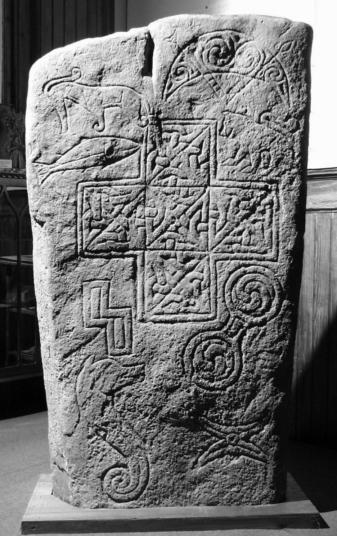
They were particularly mentioned in Cornish tales, so let's say that's true. I've no reason to think Cornish people would just pluck that out of thin air, there must be a grain off truth there somewhere. If they came north to Scottish tin mines too, they might have thought this was a great place for an outpost and so some of them stayed. Hence the stories of the Picts marrying them and keeping the secrets of the tarot. There were several stories that spoke about the northern druids, and how they were equal to the Persians (Babylonians?) in their knowledge of magic.
So let's say the Phoenicians are already here, and when Cartimandua fled, she fled north, to her own folk.
The 'Picts' commemorate this occasion, and also her demise, which lives on in the story of Guinevere.
This makes sense to me, because we all know this story, it seems 'right' that this tale would have lasted.
The interesting thing about it though, is that Guinevere was best known for the Holy Grail stories which takes us straight back to the start, at Rosslyn Chapel and the Masonic link!!
I think 4 posts to respond to you technically constitutes harassment, but bear with me!
I spent hours scanning every folklore book I own last night and the general consensus seems to be, from lore and rumour, that the Phoenicians were known in Britain - they came over looking for tin.
Tin

Bottom right symbol

They were particularly mentioned in Cornish tales, so let's say that's true. I've no reason to think Cornish people would just pluck that out of thin air, there must be a grain off truth there somewhere. If they came north to Scottish tin mines too, they might have thought this was a great place for an outpost and so some of them stayed. Hence the stories of the Picts marrying them and keeping the secrets of the tarot. There were several stories that spoke about the northern druids, and how they were equal to the Persians (Babylonians?) in their knowledge of magic.
So let's say the Phoenicians are already here, and when Cartimandua fled, she fled north, to her own folk.
The 'Picts' commemorate this occasion, and also her demise, which lives on in the story of Guinevere.
This makes sense to me, because we all know this story, it seems 'right' that this tale would have lasted.
The interesting thing about it though, is that Guinevere was best known for the Holy Grail stories which takes us straight back to the start, at Rosslyn Chapel and the Masonic link!!
beansidhe
reply to post by Logarock
I think 4 posts to respond to you technically constitutes harassment, but bear with me!
I spent hours scanning every folklore book I own last night and the general consensus seems to be, from lore and rumour, that the Phoenicians were known in Britain - they came over looking for tin.
Tin
Bottom right symbol
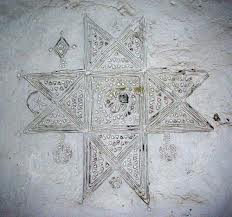
something from Carthage.
beansidhe
reply to post by Logarock
It's really good speculation, particularly as lots of sources I've read say that the Picts carried on a matriarchal lineage. You would certainly record a queen arriving on stone, particularly one loyal to the hated Romans. Of course it could tell of her being taken away by the Romans, as well.
I need to go out for a bit, but I want to have another close look at that stone!
Yes considering all abundance of things indicating a queen present. I am inclined to believe at this point that it was a precedent set well before the time of Carthimandua. Simply because of the winged disk and certain style of personal name icon on one of the stones. The idea does have precedent in the Minoan civilization. It is also interesting that Carthage had a powerful queen that somehow was given rule over her brother. It is also interesting that her name Carti is really close to the Carth. lol. Carthi.
reply to post by beansidhe
Hi its only a thought but the T - unknown is often used as a symbol for earth in astrology.
Hi its only a thought but the T - unknown is often used as a symbol for earth in astrology.
Shiloh7
reply to post by beansidhe
Hi its only a thought but the T - unknown is often used as a symbol for earth in astrology.
Hi Shiloh, that's really interesting because I'm wondering if the animals on the (class 1) stones correspond to constellations. And what makes it even more interesting still, is that Logarock has shown how Egyptian etc cultures would have used a T sign to symbolise earth -land, or more specifically those who owned land.
I've come to believe that the stones are a lot more complicated that I first thought!
reply to post by Logarock
Something else from Carthage:

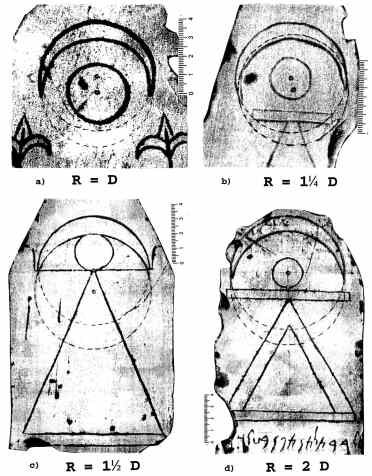
Archaeometry.org
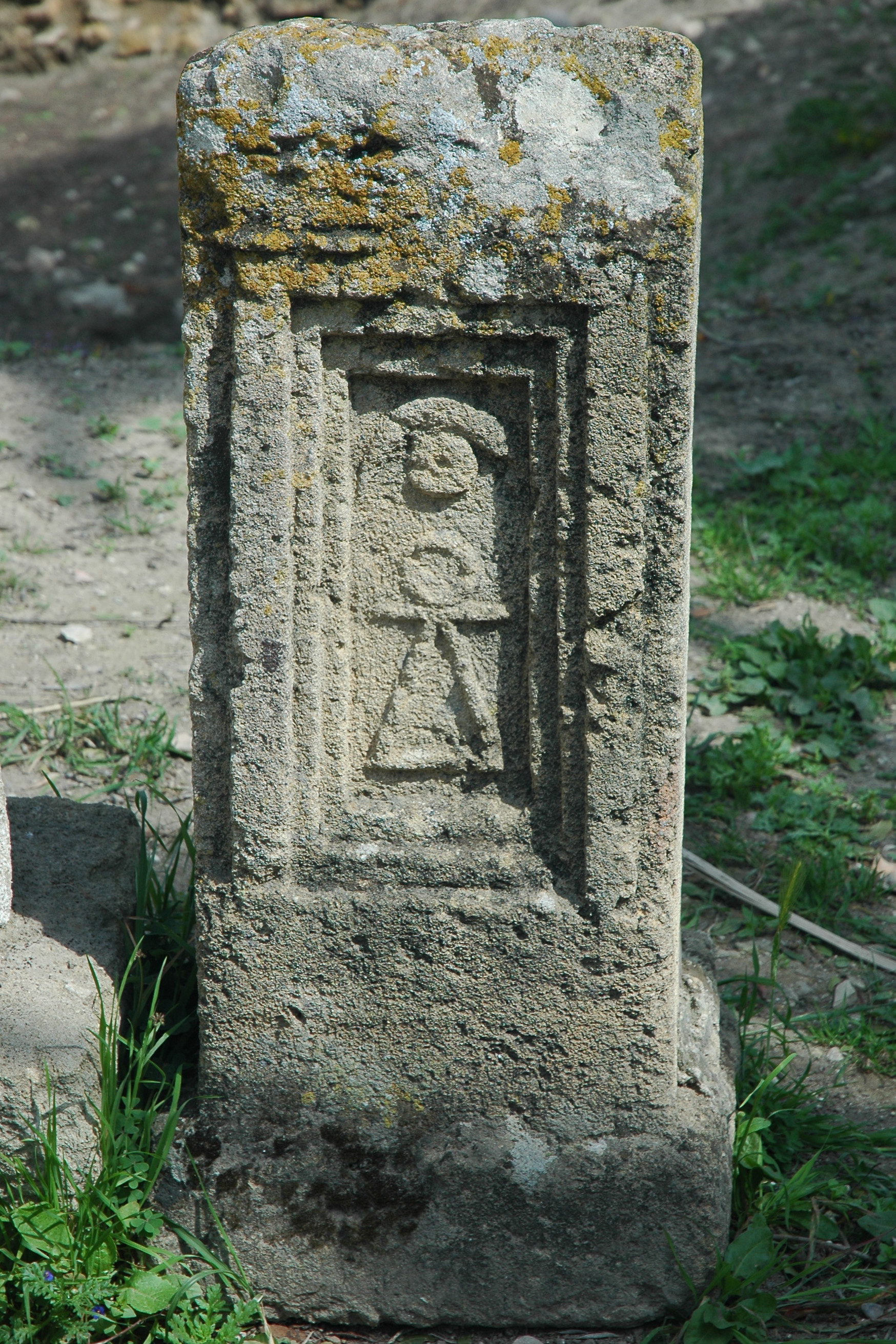
Something else from Carthage:


In the Phoenico-Punic world, prior to - 462, the "receptive crescent",
in the representation of the "sun-moon couple" symbol, cohabits
with the "protective crescent", while after - 462, the "disc and crescent" symbol,
on the votive stelae of Carthage & Motya, is found to have been engraved systematically
with the crescent in the protective position.
Indeed, Carla Del Vais [2] lists only eight stelae in Motya
which form exceptions to this rule.
The protective crescent avatar however was brutally put to an end with the Roman take-over,
and the definitive establishment of their "ideologically correct" arrangement:
the solar disc "dominating" the lunar crescent. A patriarchal symbol was born.
Archaeometry.org

edit on 18-2-2014 by beansidhe because: Added picture
There are too many examples in this book, but here's one. The name Carth does appear in Scotland - in plant names:
The Gaelic names of plants
Valerianace^e.
Valeriana officinalis — Great wild valerian. Gaelic: an tr\-
ihileach (Mackenzie); lus na tr\ bhilean (Armstrong), the three-
49
leaved plant, from the pinnate leaves and an odd terminal one,
forming three prominent leaflets. Irish : lus na tr\ ballan, the
plant with three teats (ballan, a teat); perhaps from its three
prominent stamens (Brockie); carthan curaigh (carthan, useful,
curaigh, a hero, a giant) — i.e., the useful tall plant. Welsh : y
llysiewyn, the beautiful plant ;
The Gaelic names of plants
reply to post by beansidhe
I will post more later but there looks like a connection to the word Alba and Rome and Dianna. There was a center of Dianna worship in Alba Longa where Romulus and Remus are said to have been born. As the story goes they were reared by dogs. Dogs are a big part of Dianna cult. The moon is said to be called Dianna's mirror but need to look into that more.
Anyway the inhabitants of this Alba Longa are were said to be not Etruscan and the two areas Rome and Alba experienced difficulties. Alba Longa ended up being destroyed by Rome at some point. The royal linage of the Alban kings was said to by the line driven out of Troy. Apparently what was left of them were driven out of Italy.
Alba
This may explain how and why Rome was receiving tribute from Britain long before they had to invade Britain due to the Cradogs fathers uprising.
Hay and wow! "Britmartis" was the Minoan name given to the equivalent of the female Diana figure.
I will post more later but there looks like a connection to the word Alba and Rome and Dianna. There was a center of Dianna worship in Alba Longa where Romulus and Remus are said to have been born. As the story goes they were reared by dogs. Dogs are a big part of Dianna cult. The moon is said to be called Dianna's mirror but need to look into that more.
Anyway the inhabitants of this Alba Longa are were said to be not Etruscan and the two areas Rome and Alba experienced difficulties. Alba Longa ended up being destroyed by Rome at some point. The royal linage of the Alban kings was said to by the line driven out of Troy. Apparently what was left of them were driven out of Italy.
In Roman mythology, the Kingdom of Alba Longa was an ancient monarchy located in the present-day region of Latium in Italy.[1] Its capital was Alba Longa but it included other cities such as Lavinium and Latium.[2][3] Although archaeology has confirmed that Rome was founded by a colony of people from Alba Longa, there are no historical records for the period.[4]According to legend, after the fall of Troy, the Trojan prince Aeneas led a band of refugees driven by destiny to found a new city, eventually arriving in Italy. The traditional date of the war was established by Eratosthenes as 1183 BC, leaving a gap of some four centuries until the traditional founding of Rome in 753 BC. The genealogy of the Alban kings justified the close ties between Rome and its Latin communities, and enhanced the status of Latin families who could claim descent from a legendary ancestor. Such was the eagerness to claim a Trojan pedigree in the Late Republic that 15 different lists of the Alban kings from Aeneas to Romulus survive.[5]
Alba
This may explain how and why Rome was receiving tribute from Britain long before they had to invade Britain due to the Cradogs fathers uprising.
Hay and wow! "Britmartis" was the Minoan name given to the equivalent of the female Diana figure.
edit on 18-2-2014 by Logarock because: n
reply to post by Logarock
This may explain how and why Rome was receiving tribute from Britain long before they had to invade Britain due to the Cradogs fathers uprising.
Hay and wow! "Britmartis" was the Minoan name given to the equivalent of the female Diana figure.
This could explain it, and also why the people of that area knew about the tin mines. I had no idea this was going to be so complicated, it's fascinating and your input is just phenomenal.
'Britmartis' - nothing surprises me now!!
beansidhe
Oh my. Same hat.
Minoan. See its just the same old game over the years.
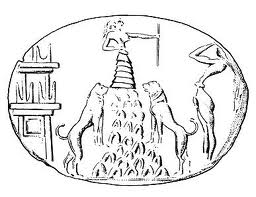
beansidhe
reply to post by Logarock
This may explain how and why Rome was receiving tribute from Britain long before they had to invade Britain due to the Cradogs fathers uprising.
Hay and wow! "Britmartis" was the Minoan name given to the equivalent of the female Diana figure.
This could explain it, and also why the people of that area knew about the tin mines. I had no idea this was going to be so complicated, it's fascinating and your input is just phenomenal.
'Britmartis' - nothing surprises me now!!
So is yours. This is such an interesting thing here. You know, I grew up in a town called New Albany... but until just now.....lol.
reply to post by Logarock
Ha ha ha! No!! If you find a Pict stone in New Albany, crush it, powder it into dust!
It is absolutely fascinating, no wonder they've never been decoded -yet!
So from the Minoans, the 'Albans' through to the Phoenicians, to the Carthaginians - to Scotland? The art remains the same, and the indigenous people absorb these cultural icons until they become their own unique style. They're similar to Q-Celtic, but not close enough.
I'm going to have a better look at some Phoenician/Carthaginian symbols. I wish I'd paid more attention at school in Latin!
But just to add fuel to the fire, one of the stories I read last night was from Cornwall, and told of the Phoenician troll (they'd turned the memory of them into fairies by then) who used to appear to people, since he had long retired from his real job of building Solomon's Temple!
Ha ha ha! No!! If you find a Pict stone in New Albany, crush it, powder it into dust!
It is absolutely fascinating, no wonder they've never been decoded -yet!
So from the Minoans, the 'Albans' through to the Phoenicians, to the Carthaginians - to Scotland? The art remains the same, and the indigenous people absorb these cultural icons until they become their own unique style. They're similar to Q-Celtic, but not close enough.
I'm going to have a better look at some Phoenician/Carthaginian symbols. I wish I'd paid more attention at school in Latin!
But just to add fuel to the fire, one of the stories I read last night was from Cornwall, and told of the Phoenician troll (they'd turned the memory of them into fairies by then) who used to appear to people, since he had long retired from his real job of building Solomon's Temple!
reply to post by Logarock
Me neither, but here's a thing. If the Z in the Z rod signifies weapon from the Phoenician alphabet, could the disks be shields?
Here is an example of a Minoan shield, from a mural at Knossos palace:
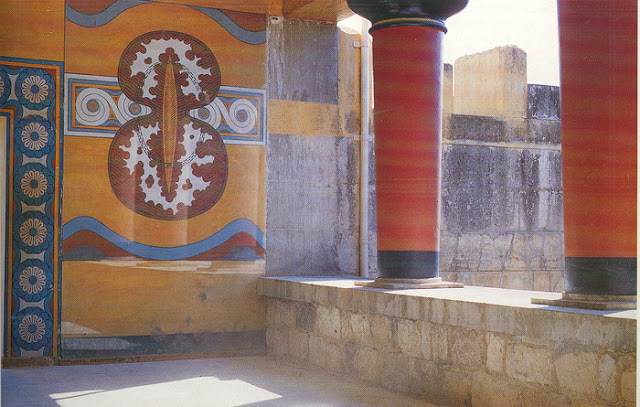
It's a bit of a coincidence!
Me neither, but here's a thing. If the Z in the Z rod signifies weapon from the Phoenician alphabet, could the disks be shields?
Here is an example of a Minoan shield, from a mural at Knossos palace:

It's a bit of a coincidence!
And again, this symbol:

Bottom left:
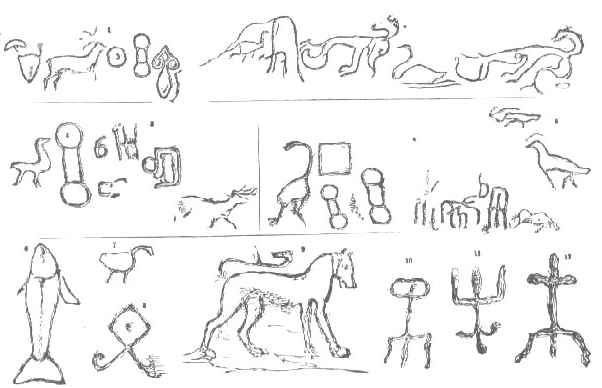
patagonia monsters
The blog in question is from a man who claims to have found signs of Phoenician art and symbolism in Patagonia.
And the 'pitchfork' in the bottom left, seen again on the Bourne rock, showing more Phoenician carving:
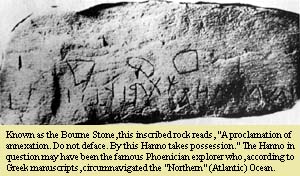

Bottom left:

patagonia monsters
The blog in question is from a man who claims to have found signs of Phoenician art and symbolism in Patagonia.
This symbol is actually a letter belonging to an ancient writing system, the Tifinagh alphabet. It is a "Lybico-berber" character that has been used by Berber speaking people of North Africa and also, the Canary Islands for several hundreds of years between, the third century B.C., and up to around the third century A.D. The arrival of the Muslim Arabs after 600 AD led to its demise.
What is a Berber symbol doing in a native Patagonian sculpted stone?
Carthage, was a Phoenician colony in Tunisia, North Africa, which was later razed by Rome after the Punic wars. The Tifinagh alphabet incorporated several Punic - Phoenician letters. This is a tenuous but clear link between Phoenicia and Patagonia.
And the 'pitchfork' in the bottom left, seen again on the Bourne rock, showing more Phoenician carving:

new topics
-
Simple Thanksgiving
Food and Cooking: 2 hours ago -
Trump could make a peaceful American Revolution
US Political Madness: 5 hours ago -
Trump Presidential Transition Team will not use GSA or Government entities to come to DC
US Political Madness: 5 hours ago -
Mind Blowing Cave under someones land
Fragile Earth: 6 hours ago -
The Party of Peace - Trump Cabinet Picks Targeted with Death Threats
US Political Madness: 7 hours ago -
V.P. Kamala Harris releases a video and nobody understands why
US Political Madness: 10 hours ago
top topics
-
D.B. Cooper mystery may be solved
General Conspiracies: 14 hours ago, 21 flags -
V.P. Kamala Harris releases a video and nobody understands why
US Political Madness: 10 hours ago, 16 flags -
The Party of Peace - Trump Cabinet Picks Targeted with Death Threats
US Political Madness: 7 hours ago, 14 flags -
Trump could make a peaceful American Revolution
US Political Madness: 5 hours ago, 13 flags -
Mind Blowing Cave under someones land
Fragile Earth: 6 hours ago, 12 flags -
Trump Presidential Transition Team will not use GSA or Government entities to come to DC
US Political Madness: 5 hours ago, 12 flags -
Simple Thanksgiving
Food and Cooking: 2 hours ago, 4 flags
active topics
-
Simple Thanksgiving
Food and Cooking • 8 • : Flyingclaydisk -
I thought Trump was the existential threat?
World War Three • 107 • : cherokeetroy -
V.P. Kamala Harris releases a video and nobody understands why
US Political Madness • 65 • : bluesman023 -
The Party of Peace - Trump Cabinet Picks Targeted with Death Threats
US Political Madness • 9 • : DBCowboy -
Trump Presidential Transition Team will not use GSA or Government entities to come to DC
US Political Madness • 9 • : matafuchs -
Post A Funny (T&C Friendly) Pic Part IV: The LOL awakens!
General Chit Chat • 7838 • : GENERAL EYES -
The Acronym Game .. Pt.4
General Chit Chat • 995 • : JJproductions -
Trump could make a peaceful American Revolution
US Political Madness • 8 • : Flyingclaydisk -
Mind Blowing Cave under someones land
Fragile Earth • 14 • : Flyingclaydisk -
President-Elect DONALD TRUMP's 2nd-Term Administration Takes Shape.
Political Ideology • 254 • : WeMustCare

